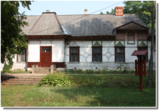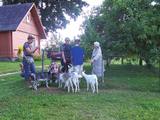| Nr | Name | Beschreibung |
|---|---|---|
|
Das Wohnhaus ist am Anfang des 18. Jhs. gebaut und in der Mitte des 19. Jhs. umgebaut worden. Immer noch werden die Erneuerungsarbeiten des Pfarrhofkomplexes durchgeführt. Seit September 2009 arbeiten in dem Pfarrhofkomplex drei Erholungshäuser des Rekollektionszentrums der Evangelisch-Lutherischen Kirche Lettlands. Neben den Häusern kann man die Reste des alten Pferdestalls sehen. |
||
|
Der Naturpark im Ort von Jūrmala wurde eingerichtet, um die Dünen, den Kiefernwald und den Küstenlebensraum zu schützen. Der Park bietet einen der attraktivsten Naturpfade im Rigenser Gebiet. Er befindet sich in der Nähe der bekannten Ragakāpa-Düne, die teilweise bis zu 17 m hoch ist. Das ist eine ausgezeichnete Möglichkeit, den Dünenlebensraum und seine Pflanzen, Vögel, Insekten usw., die hier leben, zu schützen. Man kann auch Kiefern sehen, die 100 Jahre und älter sind.
|
||
|
The tower on the eastern shore of Lake Engure (next to the meadow for wild cattle, accessible from the side of Bērzciems) offers a view of the reeds, small islands, Great Island, cows and horses of the north-eastern part of the lake. The tower on the northern shore of the lake (accessible from the side of Mērsrags) offers a look at the boating facility and the very overgrown northern part of the lake. The tower at the north-western shore of the lake (accessible from the side of Ķūļciems) shows the Apaļrova island (a footpath), stands of juniper, the boating facility, and the mosaic-like landscape of the lake itself.
|
||
|
Atrodas Labraga – Apriķu ceļa malā. Kāds nostāsts vēsta, ka to 1896. gadā cēlis vietējais muižkungs, kurš vēlējies, lai viņa meitas laulības notiktu baznīcā. Dievnamā atrodas altārglezna "Kristus pie krusta un Sv. Marija Magdalēna", kas gleznota 19. gadsimtā (autors T. Šprengels). |
||
|
Der Name von Bauska ist in den historischen Quellen zum ersten Mal 1443 erwähnt worden. Das ist die Zeit, als auf der Halbinsel zwischen den Flüssen Mūsa und Mēmele mit dem Bau der Burg begonnen wurde, die die letzte Burg des Livländischen Ordens auf dem Gebiet Lettlands war. An der Burg – auf der Insel Ķirbaksala hat sich die Ortschaft Vairogmiests herausgebildet. Im 17. Jh. blühte die Stadt schnell auf. Hier arbeiteten Goldschmiede, Silberschmiede, Tischler, Töpfer, Schuhmacher und andere Handwerker. In den späteren Jahrhunderten haben die Einwohner der Stadt unter Kriegen, unter der Pest und der Napoleonischen Armee gelitten. Heute ist die Altstadt von Bauska mit ihrem neu gebauten Rathaus und mit der erneuerten Burg von Bauska eines der interessantesten historischen Zentren der lettischen Städte. Bauska ist mit ihren jährlichen Veranstaltungen bekannt: Mit dem Festival der Alten Musik, dem Stadtfest von Bauska, dem Festival der Countrymusik u.a. |
||
|
Dole ist die größte Insel des Flusses Daugava. Von der nordöstlichen Seite wird die Insel vom Fluss Daugava umgeströmt, von der südwestlichen Seite – vom ruhigen und allmählich bewachsenen Gewässer des Seitengerinnes von Daugava. Die Insel ist ein Naturpark (das besonders geschützte Naturterritorium). Der Naturpark wurde 1987 zum Schutz der nach dem Bau des Rigaer Wasserkraftwerkes erhaltenen Landschaft und kulturhistorischen Werte der Insel von Dole, sowie seltenen und geschützten Pflanzen- und Tierarten gegründet. Noch ein Ziel des Errichtens des Naturparks ist die Förderung der Bildung und Erholung der Gesellschaft. Eins der bekanntesten Objekte der Insel von Dole ist das Daugava- Museum, das im Wohngebäude des Landgutes von Dole eingerichtet wurde. Im Fundus des Museums sind ~ 13 000 verschiedene Objekte – Zeugen der Geschichte der Insel von Dole und der Daugava-Ufer – Kleidung der Balten und Liven, Arbeitsgeräte, Alltagsgegenstände. Die Exposition macht mit der Geschichte des Flusses Daugava als mit dem bedeutenden Wasserweg und mit der Geschichte der Flößer und Transportmittel dieses Weges bekannt. Im Park des Landgutes von Dole ist eine Exposition des Museum unter freiem Himmel mit der Rekonstruktion der Neuenaugen-Fischzäune, einer Abdämmung für den Lachsfang und einer Sammlung der Fischereiwerkzeugen errichtet. Neben dm Museum befindet sich am steilen Ufer des Seitengerinnes von Daugava einen Dolomitaufschluss. Im südöstlichen Teil der Insel sind am Daugava-Ufer neben dem Haus “Bēči” die Ruinen der Burg von Vecdole zu finden. |
||
|
Muižas pils (no sarkaniem ķieģeļiem celta) ir meklējama ceļu krustojumā pie Gaujām – 2 km ziemeļaustrumos no Jaunpiebalgas centra, Gaujas labajā krastā. Līdz 1918. g. muižas īpašnieki bija slaveno grāfu Šeremetjevu dzimta. Muižas pili nodedzināja 1905. g. nemieros, bet vēlāk atjaunoja. Muižas pilī bijušas dažādas iestādes: slimnīca, kolhoza „Piebalga” administrācija, mūsdienās – pašvaldība un dažādu sadzīves pakalpojumu sniedzēji. |
||
|
Die Armeestadt von Skrunda – zurzeit ist sie nicht zugänglich und wird bewacht. Erwähnenswert ist dieser Ort mit dem berühmten Radioteleskop von Skrunda, der nach der Erneuerung der Unabhängigkeit Lettlands gesprengt wurde.
|
||
|
The tour introduces modern day life in rural Finland, Estonia and Latvia and includes visits to small farms raising livestock and producing delicious foods, and to ethnographic villages preserving the traditional lifestyle in a contemporary environment. The tour also involves sites of historical and cultural interest. |
||
|
Auf der Route kann man einzigartige und in Lettland bisher noch nicht gesehene Landschaften sehen! Die eindrucksvolle Steilküste der Ostsee beginnt einige Kilometer nördlich des Dorfs Pāvilosta, endet kurz vor dem Dorf Ošvalki und sie ist fast zwanzig Kilometer lang. Ihre eindrucksvollsten und einzigartigsten Formen sind auf der Strecke Strante – Ulmale zu besichtigen. Die ganze Route führt auf der ehemaligen westlichen Grenze des Eisernen Vorhangs, weil die Küste der Ostsee während der Sowjetzeit eine Militärzone und einfachen Menschen nicht zugänglich war. Auch heute kann man noch die Reste der Militärobjekte und die alten Wege der Panzer in den Küstendünen sehen. In der Umgebung von Ventspils und Užava dehnen sich kilometerlang die in den baltischen Ländern größten Biotope der grauen Dünen. Diese Landschaften sind ungewöhnlich und anderswo in Europa ganz selten zu sehen. Hier kann man mehr als zehn Kilometer wandern, ohne einen Menschen zu treffen. Route information from Latvijas Lauku forums |
||
|
Zemnieku saimniecībā "Rudzīši" iespējams apskatīt dažādus mājputnus - vistas, tītarus, dažādu šķirņu pīles un zosis. Mini zoo mīt arī cūkas, aitas un kazas. Tiek piedāvāta izjāde ar poniju, kā arī iespēja pārnakšņot brīvdienu mājā. |
||
|
Jēsū – Kepu ceļa malā pie Leti (Läti) ciema ir izveidots autostāvlaukums ar putnu vērošanas torni, no kura paveras skats uz Hallistes upes palieņu pļavām un tuvējā ciema apkārtni. Stipru palu laikā arī no šī torņa redzamā apkārtne (izņemot ceļus) var atrasties zem ūdens. Laba putnu vērošanas vieta. Läti tulkojumā no igauņu valodas nozīmē Latvija. |
||
|
Embūtes dabas parks, saukts par Embūtes senleju, ir viena no skaistākajām, interesantākajām un noslēpumainākajām Kurzemes vietām. Nav Latvijā otras tādas vietas, kur ieejas vārtus dabas parka teritorijā simbolizē stilizēti zobeni ar vairogiem ceļa abās pusēs, radot mītisku un cienījamu noskaņu. Par Embūtes apkārtnes vēsturi stāsta daudzas teikas un leģendas. Viena no pazīstamākajām ir romantiskā teika par kuršu vadoņa Induļa un vācu komtura meitas Ārijas mīlestību. Vietā, kur viņi pirmoreiz tikušies joprojām atrodas Ārijas un Induļa ozoli. Embūtes dabā parkā ieteicams apskatīt - ekotūrisma taku, Embūtes viduslaiku pilsdrupas, Embūtes luterāņu baznīcas mūrus, Induļa pilskalnu, Pilskalna avotiņu, Induļa un Ārijas ozolu. Dabas parks aprīkots ar labiekārtotu pastaigu taku, skatu platformām, skatu torni, labierīcībām un atpūtas vietu. |
||
|
Umfasst das Tal des größten Flusses Litauens Nemunas zwischen den Siedlungen Seredžiaus und Geldaudišķis mit malerischen Blicken auf Burgberge, mittelalterliche Burge und Landgüter. |
||
|
Zosna (Veczosna) Manor. The building is surrounded by a small park near the bank of Lake Rāzna.
There are 39 different species of trees and bushes. It was built in 1870 by the order of duke Goļicins. It is
one of the rare truss buildings in Latgale.
|
||
|
Latgale Farmstead „Mežmalas”. The owners of the farmstead created an interesting collection of the old
household items, tools and equipment of the 19th and 20th century. The visitors are offered to try plainting of
the scale basket. Sale of baskets and herbal tea. Enjoy walking along the energetic path through the pine forest.
Working hours: on request |
||
|
Interesanta dažāda vecuma ēku ieskauta gājēju ieliņa (gājēju daļa ~ puskilometrs), kura var novērot pilsētas arhitektūras stilu attīstību no 17. - 20. gs. Šeit tāpat kā citur Kuldīgā var apskatīt un nofotografēt pilsētai raksturīgos virsgaismas lodziņus un greznās un daudzveidīgās ēku durvis. Te vērts pasēdēt arī krodziņā! |
||
|
The Vecročupe river flows out of the artificial Vaide pond. It was created by blocking the Vaide and the Kukšupe rivers. This happened during the Soviet occupation, when forestry people decided to establish a fishing pond and an area for recreations. A wooden pergola has been installed at the pond, and there is an information stand, as well. On the northern shore of the pond is the Vaide cemetery, which dates back to 1928 and has interesting wooden crosses. |
||
|
Einer der seltenen Kokle-Bauer, der selbst Instrumente baut und anderen beim Bau hilft, indem er Meisterkurse organisiert. Er baut auch andere lettische Volksinstrumente, erzählt darüber, demonstriert sie, berät, sammelt Instrumente und historische Informationen. Er ist im Handwerkerhaus von Drabeši (Drabešu Amatu mājā ) tätig, wo Interessenten auch andere traditionelle Handwerke erlernen können – Weben, Lederverarbeitung, Filzen, Töpfern und eben den Bau von Musikinstrumenten. |
||
|
In der Mühle lässt sich der Wollverarbeitungsvorgang auf 100 Jahre alten Geräten nachverfolgen, hier werden Wolldecken und mit Schafwolle gefüllte Kissen in Handarbeit hergestellt, sowie Souvenire, die man kaufen und bestellen kann. Es werden Exkursionen angeboten und Brot gebacken. Funktionsfähig erhalten ist die im 19. Jh. im lettischen Maschinenwerk „Šūberts Rudzīts & b-dri” hergestellte Pflück- und Kardiermaschine, eine in Deutschland hergestellte einzigartige Spinnmaschine sowie eine Kornmühle. Lettische Küche: Eingelegte Heringe mit Gemüse, Graupengrütze, Kartoffelpüree nach dem Geschmack der Einwohner von Vidzeme (mit gebratenen Zwiebeln), kleine Pfannkuchen mit einheimischem Honig und Marmeladen aus einheimischen Beeren, selbstgebackenes Brot. Das besondere Gericht: Wasserkringel und Suppe des Wirtes, die aus sechs Fischarten gekocht ist. |
||























